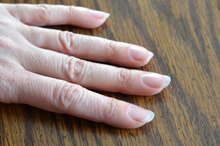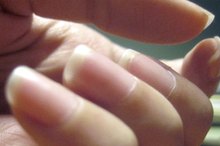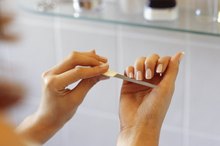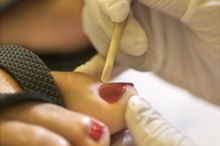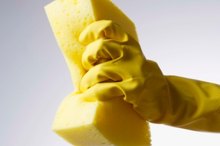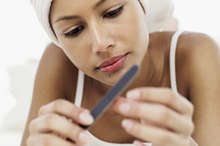How to Repair Nail Beds
Tips
White spots or lines in your nail bed are often from injuries that you may not be aware of when they occur. These spots or lines are harmless and disappear as the nail grows out.
Warnings
While wearing nail polish gives them extra protection against chipping and breaking, avoid harsh polish removers that contain formaldehyde or acetone.
Daily care of your nail beds is the best way to repair them of ridges, spots, cracks and dryness. Nail bed problems often result from diseases or other conditions. For instance, thin nails with raised ridges and a concave shape is one sign of iron deficiency, according to WebMD. White nails can indicate liver disease, red nails may indicate heart disease -- so it's vital you check first with a doctor or dermatologist to rule out any of these conditions. Other signs that indicate the need for medical attention are curling nails, dents, pitting in the nail bed, yellow nails or dark lines underneath the nail bed.
Keep your nails dry to prevent them from being weak. Clean, dry nails help them stay healthy. Use rubber gloves when washing dishes or working with soap and water or other cleaners. Wear gardening gloves when working in the yard, according to the Mayo Clinic 2.
How to Heal a Damaged Cuticle
Learn More
Moisturize your hands and nails after washing them a few times each day. Use a rich hand cream that contains phospholipids, urea or lactic acid. These help prevent the nails from cracking, says WebMD. Massage the moisturizer into the nail beds and end of your nails. Use the cream again at night before going to bed and wear cotton gloves to help them absorb the moisture and make them strong.
Ask the manicurist not to cut away your cuticles. They protect the nail bed and are there for a reason. Pushing them back gently with an orange stick is acceptable, but avoid cutting the cuticles.
Weak Fingernails
Learn More
Trim your nails on a regular basis with nail clippers and file them afterward. File your nails in one direction only. Sawing back and forth with a file weakens the nail and nail bed.
Purchase a biotin supplement, according to the Mayo Clinic, taking 2.5 mg of biotin is thought to increase the nail thickness, protecting the nail beds from damage.
Related Articles
References
- WebMD: Healthy Fingernails: Clues About Your Health
- Mayo Clinic.com: Nails: How to Keep Your Fingernails Healthy and Strong
- Singal A, Arora R. Nail as a window of systemic diseases. Indian Dermatol Online J. 2015;6(2):67-74. doi:10.4103/2229-5178.153002
- Yaemsiri S, Hou N, Slining MM, He K. Growth rate of human fingernails and toenails in healthy American young adults. J Eur Acad Dermatol Venereol. 2010;24(4):420-3. doi:10.1111/j.1468-3083.2009.03426.x
- Schons KR, Knob CF, Murussi N, Beber AA, Neumaier W, Monticielo OA. Nail psoriasis: a review of the literature. An Bras Dermatol. 2014;89(2):312-7. doi:10.1590/abd1806-4841.20142633
- Abdullah L, Abbas O. Common nail changes and disorders in older people: Diagnosis and management. Can Fam Physician. 2011;57(2):173-81.
- Sarkar M, Mahesh DM, Madabhavi I. Digital clubbing. Lung India. 2012;29(4):354-62. doi:10.4103/0970-2113.102824
- Haneke E. Controversies in the treatment of ingrown nails. Dermatol Res Pract. 2012;2012:783924. doi:10.1155/2012/783924
- Jefferson J, Rich P. Melanonychia. Dermatol Res Pract. 2012;2012:952186. doi:10.1155/2012/952186
- Aging Changes in Hair and Nails. Medline. National Institutes of Health Public Information Sheet.
- Nails and Nail Problems. American Academy of Dermatology Public Information Sheet.
Writer Bio
Chelsea Fitzgerald covers topics related to family, health, green living and travel. Before her writing career, she worked in the medical field for 21 years. Fitzgerald studied education at the University of Arkansas and University of Memphis.
